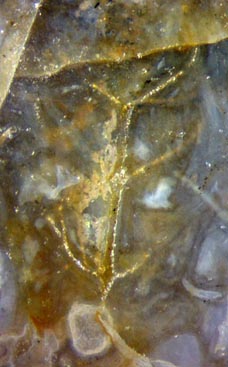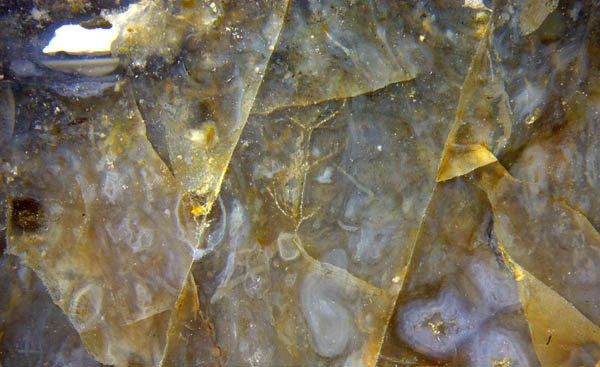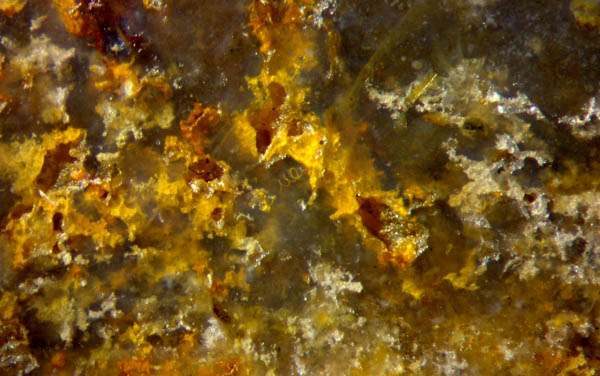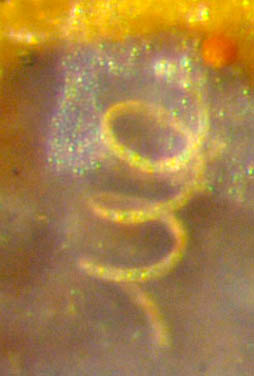Water turned into Devonian
chert


Contrary to the widespread notion that chert is silicified
sediment (after Wikipedia), the
most interesting fossiliferous cherts, like the famous Rhynie chert,
had been formed via silica gel from water-logged or watery habitats
with plants and creatures. As
an advantage over sediments, cherts from watery
locations may preserve things in their natural positions and shapes. Palaeonitella, a
delicate water plant related to the extant stoneworts (Chara and Nitella),
is abundantly found in upright position in the chert sample of which a
10mm wide area is
shown in Fig.1. Most fragments are vaguely seen in the depth but
incidentally a hollow one with three whorls of branches is positioned
so precisely in the cut plane that the central cavity is cut into half
lengthwise between the whorls (Figs.1,2).
As a general phenomenon with Palaeonitella, the
tubular cells in
the chert can be hollow, with tiny quartz crystals along the inside.
Often the glittering quartz lining is seen in the depth but the outer
cell wall is not, which may be more or less misleading concerning cell
diameters. (Note that, like with extant Nitella, tube diameter = cell
diameter.)
Swamp gas bubbles had been later filled with
water, then with bluish chalzedony and quartz crystals, or with level deposits
and white quartz powder, as seen above left.


Fig.1 (above): Silicified watery habitat with Palaeonitella
(Green Alga), upright in Rhynie chert, hollow specimen incidentally cut
along its axis (in the middle of the picture), horizontal
layers
in a former cavity above left indicating the orientation.
Fig.2 (above right): detail of Fig.1,
picture width 2mm.
Fig.3
(far left): Silicified water with enigmatic rugged inclusions, the
larger ones hollow, often with stained walls, among them one tiny Nematoplexus
spiral, seen in the middle of the picture of 4mm width.
Fig.4: Nematoplexus
spiral from Fig.3, three full turns: rare sight.
Picture width 0.2mm, spiral width
0.09mm.
All pictures have been taken from the sample Rh5/3 found by Sieglinde Weiss
near Milton of Noth in 2001, Slab 2A.
Fig.3 is to show how confusing the aspect of
the cut and polished chert face may be even though the chalzedony is
rather clear so that enclosed objects are seen in 3D, like the solitary Nematoplexus
spiral. It can be concluded that this chert
sample serves an another piece of
evidence that clear water can turn into clear
chalzedony. (There is lots of more evidence, for example Rhynie
Chert
News 23
, 71
, 74.)
Here, the rugged objects
in Fig.3 cannot even tentatively be interpreted. Their chaotically
irregular
outer and inner surfaces seem to be fine-grained with crystalline
quartz.
Nematoplexus,
first described in 1961 and affiliated with the enigmatic
nematophytes,
then found in a few own chert
samples since 2001 and compiled
recently, is still one of the rarest fossils in the Rhynie
chert. Although the present sample has been thoroughly inspected on 10
cut faces, mainly for charophytes, no other Nematoplexus
spiral than this one has been found.
H.-J.
Weiss
2018
 |
 |
123 |







